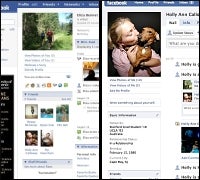 |
You would think that Facebook had just stepped on the toes of its 110 million users worldwide, judging by the reaction to the social network’s recent redesign.
From the outcry, the new Facebook design, rolled out Sept. 10, upset both critics and millions of users. But it may not matter to Facebook’s business model, even though millions still say they are dissatisfied with the new look.
The votes rolled in during the testing phase prior to launch in July of this year when Facebook invited users to toggle between the new Facebook and the old one. Over the next six weeks, some 40 million people joined the testing, with 10 million of them voting to switch back to the original design. After the new Facebook launched on Sept. 10, users were in full revolt.
In response to the new Facebook, nearly 10 million irked Facebook users have joined a dozen protest groups. Members of the largest protest group, “1,000,000 Against the new Facebook,” now some 3 million users, are even calling for a boycott of the site during the weekend of October 18.
E. A. Vander Veer, author of “Facebook: The Missing Manual,” said change by itself is not trivial, especially when the site’s interface is pretty much who you are to other users. “If you woke up one morning and someone changed how bread works, we wouldn’t put up with that in a minute,” he said.
Facebook took a neutral position in its official reaction, which it attributed to Mark Slee, Facebook’s lead product manager. “We’re flattered to have such passionate users provide feedback on the new site design, and we’re pleased to see them sharing their views, which is what Facebook is all about.”
 Facebook’s old look (left) and its new design (right). Click to enlarge. Source: Facebook |
So what was all the fuss about? The new Facebook rolled out four broad enhancements: Chronological information feeds for users; navigation with tabs; easier information sharing of photos, links, videos and third-party content and applications; general layout adjustments.
The redesign also pushed an advertising-based business model front and center in the layout. Additionally, resistance to learning the new design may weed out non-engaged and non-revenue-producing users by way of defection, said experts. “Social networking sites like Facebook face the same pressures as other businesses,” said Bruce D. Temkin, vice president and principal analyst, Customer Experience at Forrester Research. They need to make money.
“The problem with trying to do it with advertising in this setting is that people view Facebook as their private spaces,” Temkin said. “So many Facebook users may feel a bit betrayed by the ‘insertion’ of advertising.”
Facebook also may be attempting to weed out non-revenue producing users, another way of driving down costs, said Vander Veer. “As a user, I wasn’t feeding directly into Facebook’s revenue stream, so maybe it’s okay for Facebook that I drop off.”
Facebook denies this claim, saying it values all users and their feedback feedback. “We are still working on the site and are committed to making Facebook better for all users,” Slee said in an e-mail comment.
Facebook’s efforts at getting the redesign right weren’t all bad, regardless of all the griping. Temkin’s Forrester Research report “Facebook And MySpace Redesign Sites, But Usability Remains Flawed” evaluated Facebook’s redesign on a 10-point scale. In particular, Facebook performed well with prioritizing content and layout for easy visual scanning, according to Temkin.
The report said Facebook has an inefficient task flow, problems with text legibility, and insufficient security policies.
In the end, the very nature of social media sites may minimize the loss of users. “Social media sites have a couple of advantages over many other sites in this area,” Forrester’s Temkin said. “First of all, there is a fairly steep cost to switching in terms of the content that users have created in their own Facebooks as well as in the network of their friends that are already on Facebook. Also, since they tend to regularly use the site, they are more likely to learn how to navigate through the new user interface, lowering the potential negative impact of any usability issues.
“I think that the reaction will be relatively short-lived, and cause a minimal amount of defection,” Temkin added. “As long as Facebook does not disrupt the core value and capabilities of the site, then existing users will probably adjust to the new design.”
For many, the novelty never wears off, regardless of how bothersome learning a new interface is.
“It’s like crack and very addictive,” says Jessica Fishbein, co-administrator of the group “1,000,000 Against the New Facebook” and a high school English teacher based in Aventura, Fla. “I don’t think you’re going to be seeing a mass exodus.”


